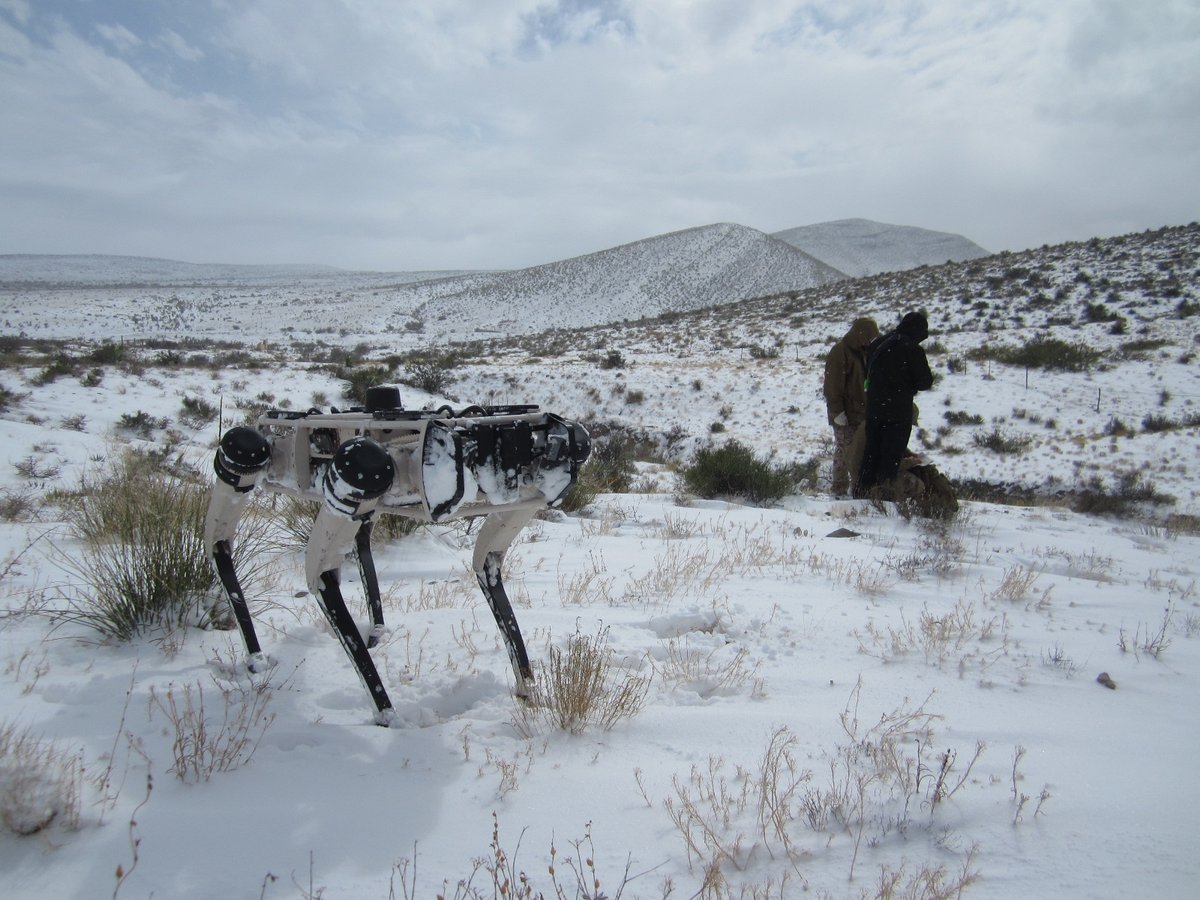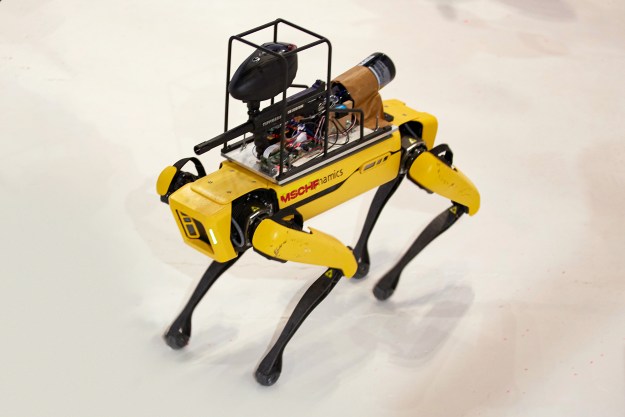“We try not to refer to them as robot dogs,” said Jiren Parikh, the president and chief executive of a Philadelphia-based company called Ghost Robotics. “We refer to them as Q-UGVs: Quadrupedal Unmanned Ground Vehicles.”
Ghost’s Q-UGVs, which look a whole lot like robot dogs, aren’t your average metal mutts. Picture Boston Dynamics’ Spot robot, probably the world’s most famous robotic canine, but in a series of inhospitable environments — on freezing mountains in the snow, splashing through ditches, scrabbling up flights of steps in a dilapidated building — rather than in a comfy lab or the gently sloping banks of a Silicon Valley research lab. That’s where Ghost’s ruggedly individualistic dog-bots look at their happiest. Presentations given by Parikh showing off the robots’ capabilities make liberal use of words like “durable” and “unstoppable.”
In short, Ghost’s quadrupedal canine bots are the scary older brother of every other dog robot you’ve ever seen. And with good reason, too. They’re shipping off to join the military.
The future of military robots
With a high-pitched hum, augmented by a bass-heavy hydraulic hiss, the ramp of an Air Force transport aircraft lowers to the tarmac. Several uniformed troops, clad in camouflage fatigues, disembark. Behind them trot two of Ghost Robotics’ Q-UGVs. Once they hit the ground, one robot immediately heads left, the other goes right, both departing to secure the area the plane has landed in and scope out any potential threats.

This is a vision of one of the many ways robots will be used in the military. But it’s not pure speculation. This scene, exactly as described, was a demonstration carried out by Ghost Robotics earlier this year at an Air Force base. “Imagine every time [the Air Force goes] somewhere to refuel, to pick up supplies, or to protect our fighter jets on the tarmac, our robots climb out and do perimeter security,” Parikh said.
Ghost’s Vision 60 robots will soon be used to patrol on base, enhancing security and surveillance, at Tyndall Air Force Base, east of Panama City, Florida.
Initially, these robots are remote-controlled by an operator (“We’re going to be building a cooler one, instead of using a pair of joysticks and a Samsung phone”), but that could soon change. “Maybe nine months from now, 12 months from now, you’ll be able to beam a map to the robot, and it’ll do another route [with a geofence perimeter],” Parikh said. “You can get better and better, and do more unique things. But let’s start somewhere.”
In the beginning
Ghost Robotics started life as a research project at the University of Pennsylvania, where co-founders Gavin Kenneally and Avik De were doing their Ph.D.s in the GRASP Lab (that’s the General Robotics, Automation, Sensing and Perception laboratory at Penn).
“I met Gavin and Avik in late 2015,” Parikh said. “They had built this cute, small robot, the Minitaur. I was like, ‘I’ll join you guys if you want to go out … and build this [in a way that can have utility for customers].’ That’s the first question I asked … I said, if you build another Boston Dynamics robot … I don’t want any part of this. Because we’re going to get our lunch eaten.”
As it turned out, Parikh was simpatico with the two budding roboticists. When he suggested that they focus on a market like the military, which has plenty of need for robots and a budget to match, they agreed. Much of Kenneally and De’s Ph.D. work had been funded by a combination of the Air Force, Navy, and Army, and they were eager to continue in that direction.
The latest Vision 60s ground drone prototypes in desert sand paint job shipping to our defense and homeland security customers this week. @USArmy @USNavy @usairforce @mhasingapore @AustralianArmy #defense #defence #autonomous #drones pic.twitter.com/b6NbXd0H6i
— Ghost Robotics (@Ghost_Robotics) July 21, 2020
The robot they had developed, a four-legged canine-looking robot, was a platform robust enough for the kinds of hardscrabble applications the military might want to use it for. Under Parikh’s guidance, what followed were several years of iteration as the team refined its creation, ultimately producing a durable robot that’s able to walk for 7.8 miles, or 3.5 hours, on the trot, moving at speeds of 6.6 feet a second. (A future, larger version will be able to walk 7.8 miles or 3.5 hours.) It’s tough. It’s water-resistant. If it’s somehow knocked over, it can contort its legs like a gymnast, swiveling them around to right itself in a rapid motion that allows it to run with its body either right side up or upside down.
The Vision 60 robot can be used for a variety of applications. For instance, a recent video shows it kitted out with bomb-disposal equipment for Explosive Ordnance Disposal. An upcoming Ghost robot, set to be officially unveiled early next year, will further enhance the company’s creation, offering optional thermal and infrared cameras for night, MMWave, gas and motion sensors, and plenty more.
Whether it’s carrying out inspection tasks or just carrying equipment over rough terrain, it’s hard not to look at it and see that this is going to be a ubiquitous sight on the battlefields of tomorrow.
Dog soldiers
The question of military robots is a thorny one. Robots of war is a science fiction concept that, alarmingly, has crossed over into the real world over the past several decades. Organizations like the Defense Advanced Research Projects Agency (DARPA) have long funded research into artificial intelligence and robotics. Speak to virtually any aging A.I. pioneer who worked during the field’s early days, and they will tell you about long, open-ended budgets able to fund many a research lab.
As Paul Scharre observes in his 2018 book Army of None: Autonomous Weapons and the Future of War, things ramped up with 9/11. In the 1990s, spending on unmanned military technologies like drones “hovered around the $300 million-per-year mark.” After 2001, the numbers “skyrocketed,” increasing sixfold to more than $2 billion by 2005.

Robots were first utilized in ground combat during the war in Afghanistan, starting in 2002. Hermes was a 20-kilogram robot kitted out with cameras and, where needed, a grenade launcher and a 12-gauge shotgun (although a 2002 article for New Scientist noted that, “so far it has not been called upon to open fire”).
Hermes neatly summed up both the fears and hopes about military robots. Its ability to be armed with weapons was an early klaxon in the concern about killer robots that led to the Campaign to Stop Killer Robots, an initiative that has racked up support from a list of names including Stephen Hawking, Elon Musk, Apple co-founder Steve Wozniak, Noam Chomsky, Skype co-founder Jaan Tallinn, Google DeepMind’s Demis Hassabis, and others.
“We don’t want [our side] to get hurt. We want these robots to keep our people out of harm’s way.”
Yet Hermes was also designed to save lives by being used to trigger trip wires rigged with explosives or set off antipersonnel mines. To quote New Scientist’s bluntly succinct assessment again: “If Hermes gets caught in a blast, there’s one big advantage — dead robots don’t get sent home in body bags.”
Like some kind of Schrödinger’s killer robot, both narratives can be simultaneously true: Robots in the arena of war could be used to both end lives and save them.
Parikh, for his part, said that killer robots are not part of the road map for Ghost Robotics. “We’ve not heard once where [governments] want to use this for weapons,” he said. Ghost’s robots, he explained, are used for military scenarios like bomb disposal, scoping out perimeters, and identifying threats. “We know that horrible people out there are doing horrible things to our citizens and our allies,” Parikh said. “We don’t want [our side] to get hurt. We want these robots to keep our people out of harm’s way.”
Parikh said that, with Ghost Robotics, “it’s the first time in 35 years — and you can quote me — that I feel like I have a sense of purpose in what I do.”
More still to come
Ghost Robotics isn’t always going to be about dog robots — or Quadrupedal Unmanned Ground Vehicles — though. While there will continue to be innovation in the area of canine-inspired bots (look out for the “organic hybrids” he said are coming in the next few decades), Parikh doesn’t see this as the company’s one and only superstar product. Thinking of Ghost as the dog robot company would be like seeing Apple’s ambitions as being purely the iPhone company. Here in 2020? Sure. But a decade from now? Maybe not.
What Parikh sees as Ghost’s most compelling proposition is its intellectual property: The algorithmic control software, the core electronics, the custom motor controllers. “Eventually, our core IP will drive bipeds, maybe hexapeds which have six legs,” he said. “There will be next-generation prosthetics, human enhancement systems, Iron Man suits, and even ultra-agile, touch-sensitive robotic arms.” The real way to build robots, Parikh said, is to “[build them] like Star Wars, all sorts of shapes and size.”
If Ghost Robotics has its way, the future of war — and other industries where its robots may be applicable — is going to look very, very different.
Editors' Recommendations
- Meet the game-changing pitching robot that can perfectly mimic any human throw
- Part Terminator, part Tremors: This robotic worm can swim through sand
- Roving surveillance bots are coming to our cities. Luckily, they’re here to help
- Meet the Xenobots: Living, biological machines that could revolutionize robotics
- This spherical, BB-8 style robot is built to explore lava caves on the moon


